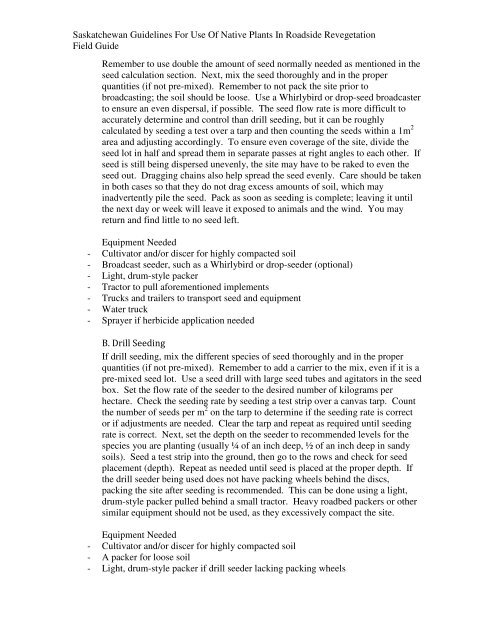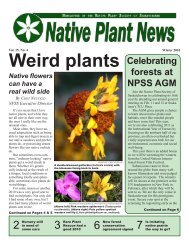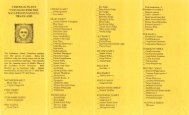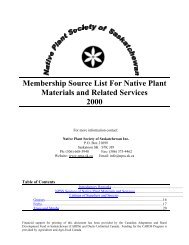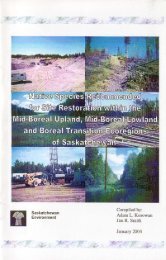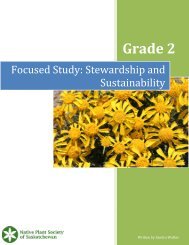Saskatchewan Guidelines For Use Of Native Plants In Roadside ...
Saskatchewan Guidelines For Use Of Native Plants In Roadside ...
Saskatchewan Guidelines For Use Of Native Plants In Roadside ...
Create successful ePaper yourself
Turn your PDF publications into a flip-book with our unique Google optimized e-Paper software.
<strong>Saskatchewan</strong> <strong>Guidelines</strong> <strong>For</strong> <strong>Use</strong> <strong>Of</strong> <strong>Native</strong> <strong>Plants</strong> <strong>In</strong> <strong>Roadside</strong> Revegetation<br />
Field Guide<br />
Remember to use double the amount of seed normally needed as mentioned in the<br />
seed calculation section. Next, mix the seed thoroughly and in the proper<br />
quantities (if not pre-mixed). Remember to not pack the site prior to<br />
broadcasting; the soil should be loose. <strong>Use</strong> a Whirlybird or drop-seed broadcaster<br />
to ensure an even dispersal, if possible. The seed flow rate is more difficult to<br />
accurately determine and control than drill seeding, but it can be roughly<br />
calculated by seeding a test over a tarp and then counting the seeds within a 1m 2<br />
area and adjusting accordingly. To ensure even coverage of the site, divide the<br />
seed lot in half and spread them in separate passes at right angles to each other. If<br />
seed is still being dispersed unevenly, the site may have to be raked to even the<br />
seed out. Dragging chains also help spread the seed evenly. Care should be taken<br />
in both cases so that they do not drag excess amounts of soil, which may<br />
inadvertently pile the seed. Pack as soon as seeding is complete; leaving it until<br />
the next day or week will leave it exposed to animals and the wind. You may<br />
return and find little to no seed left.<br />
Equipment Needed<br />
- Cultivator and/or discer for highly compacted soil<br />
- Broadcast seeder, such as a Whirlybird or drop-seeder (optional)<br />
- Light, drum-style packer<br />
- Tractor to pull aforementioned implements<br />
- Trucks and trailers to transport seed and equipment<br />
- Water truck<br />
- Sprayer if herbicide application needed<br />
B. Drill Seeding<br />
If drill seeding, mix the different species of seed thoroughly and in the proper<br />
quantities (if not pre-mixed). Remember to add a carrier to the mix, even if it is a<br />
pre-mixed seed lot. <strong>Use</strong> a seed drill with large seed tubes and agitators in the seed<br />
box. Set the flow rate of the seeder to the desired number of kilograms per<br />
hectare. Check the seeding rate by seeding a test strip over a canvas tarp. Count<br />
the number of seeds per m 2 on the tarp to determine if the seeding rate is correct<br />
or if adjustments are needed. Clear the tarp and repeat as required until seeding<br />
rate is correct. Next, set the depth on the seeder to recommended levels for the<br />
species you are planting (usually ¼ of an inch deep, ½ of an inch deep in sandy<br />
soils). Seed a test strip into the ground, then go to the rows and check for seed<br />
placement (depth). Repeat as needed until seed is placed at the proper depth. If<br />
the drill seeder being used does not have packing wheels behind the discs,<br />
packing the site after seeding is recommended. This can be done using a light,<br />
drum-style packer pulled behind a small tractor. Heavy roadbed packers or other<br />
similar equipment should not be used, as they excessively compact the site.<br />
Equipment Needed<br />
- Cultivator and/or discer for highly compacted soil<br />
- A packer for loose soil<br />
- Light, drum-style packer if drill seeder lacking packing wheels


